In 1999, Dudley Port saw the passage of over a hundred scheduled, loco-powered runs per weekday.

Loco-haulage. A relentless stream at Dudley Port canal junction in 1999.
We're now deep in the era of “bespoke trainspotting”. We usually know what's coming before we leave home, and we can monitor the journey(s) of the train(s) so that we don't have to wait around long at the location. For some, “bespoke trainspotting” has been the norm since the Blackberry era of the early to mid 2000s. For others, decades earlier. I can remember advance summer Saturday gen being shouted out from a soapbox on Sheffield station in 1981 - to a large and very captive audience, and a round of applause.
So gen, and the bespoke activity it encourages, predated the Internet by a long time. But until the early to mid 2000s, we didn't actually need to know precisely what was happening in order to head off for an enjoyable spell at the lineside. Before that, the general UK rail traffic - the normal - carried inherent interest.

No need for advance gen in the 1990s. The worst you could do with a Freightliner was a triple-grey, ex-BR 47/0.
Between 2000 and 2005, however, nearly all of the vintage locomotives and multiple units that had made the regular traffic interesting in the '90s, were stood down in favour of brand new trains with low enthusiast appeal. A new normal had struck the UK rail scene. The entire concept of lineside visits had to change.
The rise of the Blackberry device - with its ability to distribute email lists and append them live from location - couldn't have been timed more perfectly for the rail linesiders who were now finding themselves totally disinterested in 99% of the traffic. The Blackberry enabled the distribution and real time update of targeted information known to be of interest to train photographers, videomakers and spotters. That created a new culture. Highlight culture. Enthusiasts could now attend a location just for the highlight(s), and cut out most of the 'noise' they didn't care about.

Even first generation DMUs could still make occasional appearances at Birmingham New Street at the start of the 2000s. Bubble Car duo 55029 and 55031 roamed Birmingham in mid 2000 with route learning runs for Silverlink, whose trains would be subject to diversions due to the August Proof House remodelling. This is the bay behind the 'b' end of New Street's Platform 12. There was another bay behind the 'a' end.
In order to see the impact of the new normal, and why the nature of linesiding changed so dramatically, we have to remember just how fruitful the old normal had been. That's the goal of this post.
Birmingham's best yardstick to the collapse of the old normal was the Stour Valley line between Soho and Wolverhampton Steel Terminal. This section of track caught all of the steelworks' freight traffic, plus most of the loco-hauled Virgin CrossCountry expresses, Virgin West Coast's frequent Euston - Wolverhampton trains, six Class-37 hauled appearances a day on the Birmingham - Holyhead route, a number of Virgin XC HST runs, etc.

In 1999, Dudley Port - a photo vantage point within that hot traffic catchment (pictured above) - saw the passage of over a hundred scheduled, loco-powered runs per weekday, including HSTs, freight, light engine moves and evening mail. And the unit side-serving still featured classic 1960s EMUs.

Walks up the canal path from Sandwell via Dudley Port to Tipton offered a never-ending loop of photo opportunities in the late '90s. On the approach to Tipton, this is Central Trains Class 310 No. 310105. Central Trains withdrew all of their 310s by the end of March 2000.
The variety of regular classic traction at Dudley Port in '99 comprised Classes 37, 47/7, 47/8, 56, 58, 60, 86/2 (both XC and West Coast), 86/4, 87, 90, 309 and 310. If you liked the new 66s, that was an extra bonus. And there was livery variety too.

Deep back in the old normal. Trainload Coal 58035 at St. Andrews football ground in summer 1990. This was among the first traffic that the new Class 66s wrestled away from ex-BR Type 5s after they hit the scene in 1998.
The variety and volume of regular 1990s West Midlands traction was withdrawn in stages, beginning in 2000 with the 310s, then the 309s, and at the end of the year, the Class 37-hauled passenger services. The grand rundown was landmarked by a one-year period between September 2001 and September 2002, during which the Virgin Voyagers rolled out, and the classic, ex-BR CrossCountry motive power was wiped almost wholesale off the frontline map. West Coast ops met a similar fate at the hands of the Pendolinos between 2003 and 2005, progressively eliminating Virgin's 86s, 90s and 87s. The EWS 58s went in 2002, mail was run down in 2003, and the EWS 56s were canned in 2004.
So Dudley Port saw a drawn-out, progressive rundown of a realistic 100+ loco-powered trains a day at the end of the 20th century, to just the odd Class 60-hauled or Class 66-hauled freight five and a half years into the 21st.
June 2005 brought the old normal to a finality as the last Virgin 87s were taken out of traffic, but it's fair to say that the feel of the old normal evaporated at the end of summer 2002 when the CrossCountry Voyager whitewash neared completion. And the old normal was never coming back.
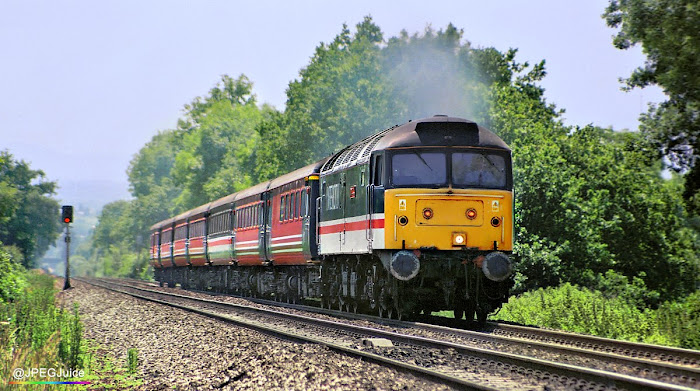
Chilling at Vigo on the Lickey Incline at the height of a 1990s summer brought a joy that took some beating. The Class 47/8s still had plenty of duties on the line, but the above duty was special in that it was the loco-hauled CrossCountry service that resisted the Voyagers for the longest. It's the 08:48 (1M56) Penzance - Manchester, seen here in the hands of 47854 'Women's Royal Voluntary Service' on 25th June 1999. Three years and seven-ish weeks later, the 1M56 ran as the last train in the loco-hauled XC timetable, bringing the era of scheduled CrossCountry Class 47 duties to an end.

Although the Class 67s were part of privatisation's renewal programme, the trains they hauled were, initially unbeknown to operator EWS, soon to be wiped out by Royal Mail's switch to road transport. Tearing through Aston fields in its year of introduction, 67016 reds up the summer of 2000 with August 29th's 12:44 Plymouth - Shieldmuir postal. This train had switched from Class 47 to Class 67 power on Easter Monday, 24th April 2000. 67016 had arrived in England on 9th March.
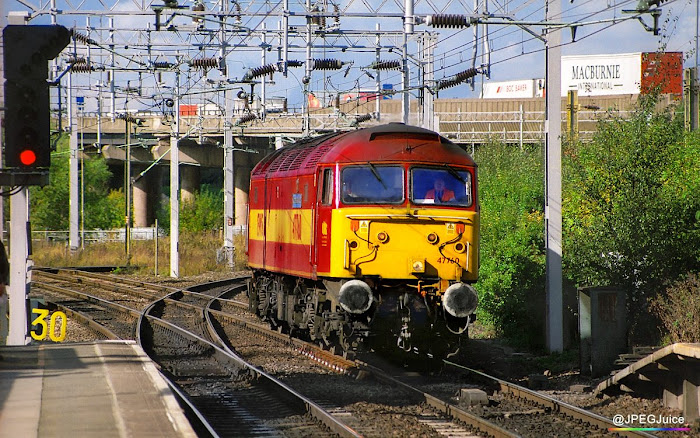
These were the locos the 67s had replaced: Railnet WHDP pool 47/7s with extended range. Only five of them received the EWS livery in the 1990s, beginning with 47785 and 47786 in 1997. The others were 47744, 47758, and the one you see above at Bescot on 12th October '99 - 47760 Ribblehead Viaduct. Further surviving examples received EWS red in the early 2000s.
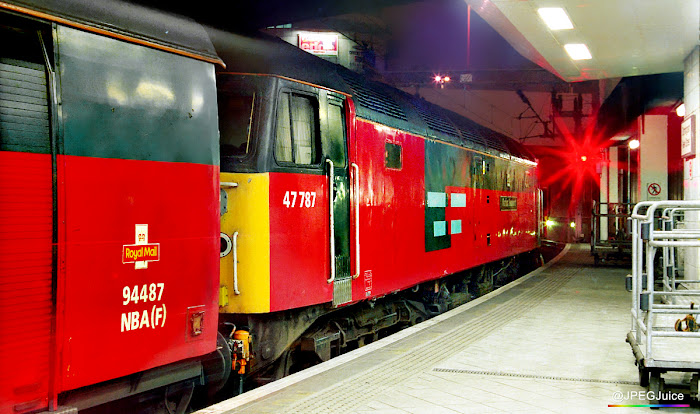
But the classic look for the mail trains prior to Class 67 intro was a matching Res liveried 47/7 and stock. This is 47787 Victim Support at New Street's Platform 12, on the 15:09 Plymouth - Low Fell, just two days before the first Class 67 working into Birmingham. Here on 21st March 2000, the arrival from Plymouth will be split into two, with the front section going forth to Gateshead behind the 47, and the rear section making its way to Warrington behind an 86. This was the most convenient platform for splitting mail trains, because the second loco could be placed in the adjacent bay. Platform 12 also gave direct access to the road mail exchange off Station Street.
IN MONOCHROME
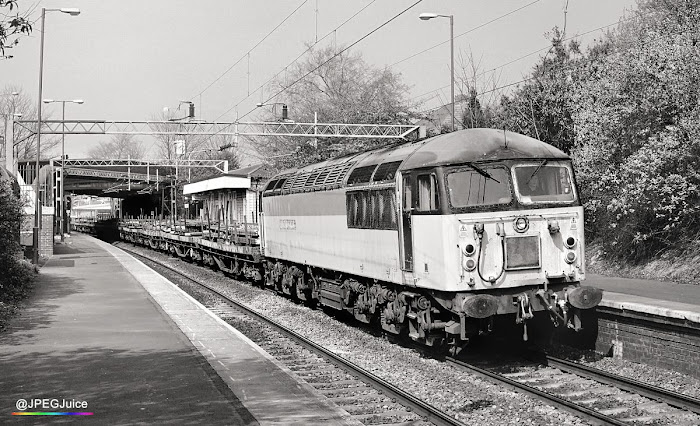
Don't worry, there's a lot more colour to come, but monochrome photography was part of the old normal, so here's a monochrome section. Monochrome's DIY, home processing element brought it closer to the economy of digital imaging than colour photography. Far fewer railway photographers work in black and white today than did in the 1990s, and there just seems to be something about old-school BR trains that suits monochrome reproduction. 56133 in unbranded BR triple grey, working the Aldwarke to Wolverhampton steel flats through Hamstead, highlights the way BR stock and black and white capture just worked.
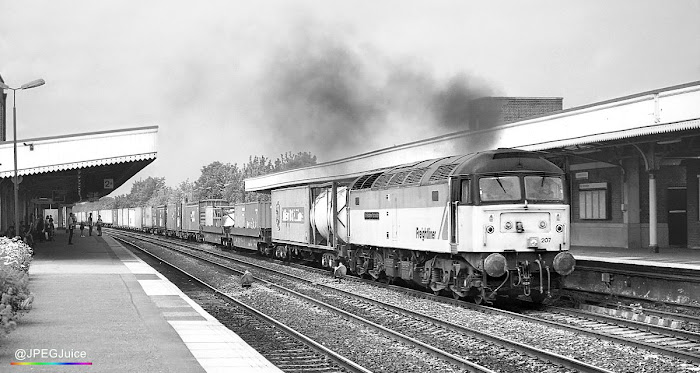
First generation diesel haulage was very much still alive at Leamington Spa on 16th June 2000, when triple grey 47207 left its clag signature on the way from Coatbridge to Southampton. I'd gone primarily to photograph CrossCountry trains, but this proved to be the shot of the day.

In the thick of the action on the Stour Valley at Coseley, InterCity liveried 87005 provides a typical late '90s vision of the Wolves - Euston traffic.

This was a poignant moment. Saturday 21st September 2002, summer season almost over, and just eight more full days to go before the launch of Operation Princess, which we all knew would destroy the remaining loco-hauled stand-ins on the Virgin CrossCountry network, as well as massively scaling down the use of HSTs. The train is the 09:17 Manchester - Paignton; a Virgin West Coast summer Saturdays only run which took a DVT down into Devon and was actually booked not just for a 47, but a 'celebrity' 47. The predictable line of photographers stood here at “Bankers Bridge”, Bromsgrove, knowing that this vision of 47851 Traction Magazine marked the end of a luxury we'd still been taking for granted just 18 months earlier.
AND BACK TO COLOUR

I've published a lot of shots of these Sunday night double-headers elsewhere on the blog, but here's another showing that even the powerful New Street extractor fans found it difficult to disperse the exhaust haze after the two 37s had finished their shunt. The consist of between eight and ten coaches would come in as First North Western's 18:22 from Holyhead - a busy boat train. After arrival at Platform 1, the EWS 'Syphons' would run round, before shutting off for a layover of more than two hours. The train would then depart as the 23:50 Birmingham - Holyhead.

We do of course still have HSTs in regular use today, but they now have a different personality due to the engine replacement programme of the mid to late 2000s. Virgin - the second biggest operator of HSTs after Great Western - was the last to complete its brand repaints, and quite a few InterCity power cars still remained at the turn of the century. They ranged in condition, but this one was about the worst. It's 43079, seen at Wychbold on 13th October 1999.

The Great Western sets didn't work into Birmingham, and they only had a limited presence at Worcester in the late 1990s, since most of the Worcester - London trains were Turbo units, as they had been since the first half of the decade. But the Great Western HSTs were worth waiting around for if you liked your trains to visually mimic the aura of a cigarette packet.
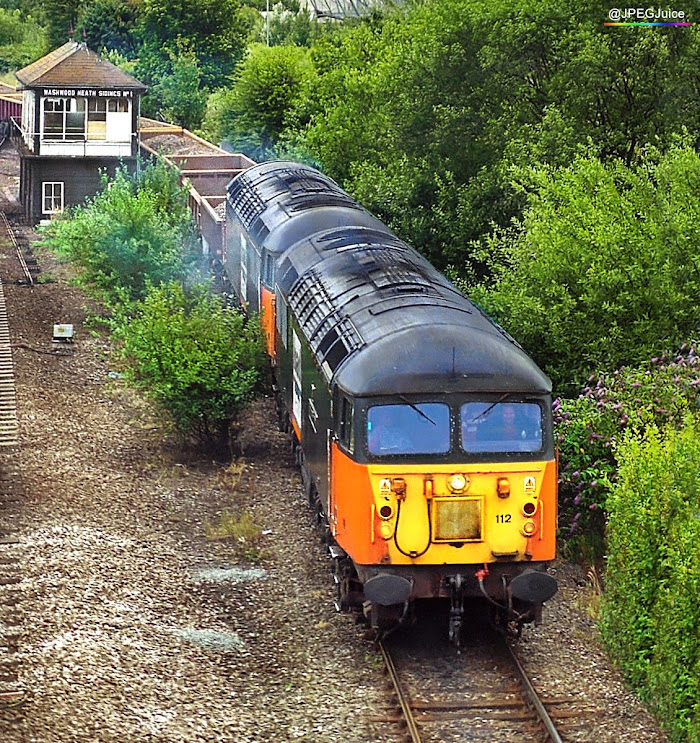
The EWS Class 56s widely carried British Rail liveries well into the 2000s. Only in the second half of 2003 as the class was being phased out did EWS red machines become overwhelmingly dominant. That was largely because the BR-liveried locos had gone the longest since general overhaul, and thus were the priority withdrawal candidates. Here at Washwood Heath on Sunday 21st July 2002, Loadhaul twins 56112 and 56118 are heading past the signal box into the yard with a long rake of loaded wagons.
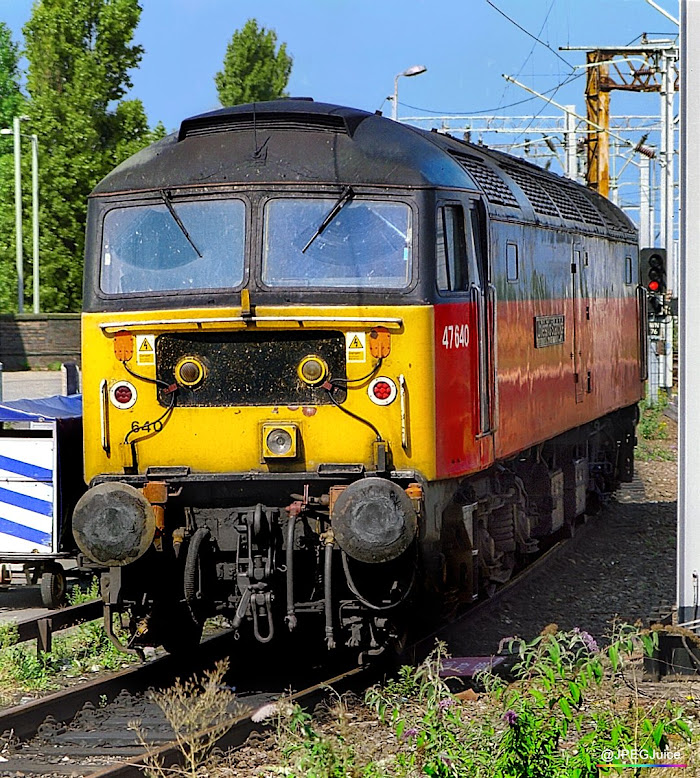
The Euston - Shrewsbury services would be Class 47-hauled from Wolverhampton. But in the late '90s, Virgin's fleet of 47/8s would rarely stretch across the whole core CrossCountry timetable - let alone any outlying West Coast diagrams. So the Wolverhampton to Shrewsbury runs became noted for their use of a Class 47 sub-type that was incompatible with much of the ILRA work - the standard range 47/4. Both EWS and Fragonset hired out these low fuel capacity machines, but EWS had a lot more of them than Fragonset, so commonly the trains were hauled by non-Railnet, mail sector 47s from the WHCN pool. Here in the allotted bay area at Wolves, awaiting its Salop expedition, is old Parcels liveried 47640 University of Strathclyde.

An evening scene from Birmingham New Street on 30th December 2001, contrasting a remnant of 1960s electric power with an early 1990s diesel train. Virgin Trains' 86260 was in from London Euston, while 158847 had made the journey from Aberystwyth. The 158's green livery was applied by Central Trains in 2000, but since then the unit had moved to Wales & Borders and been rebranded by the new operator.
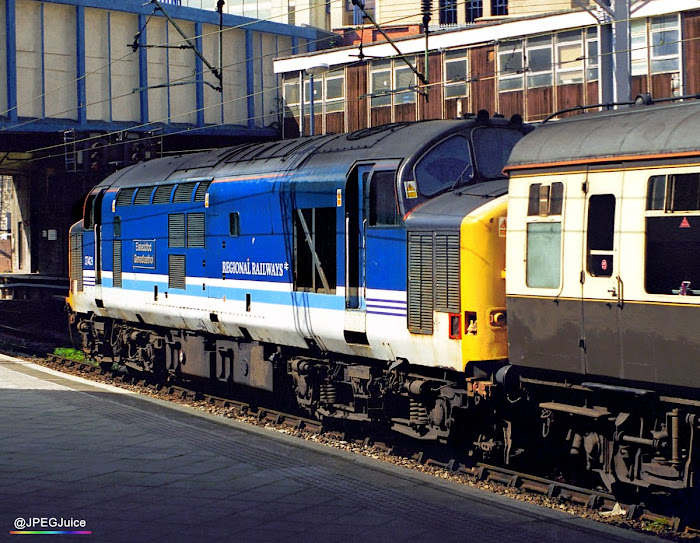
On this occasion in summer 1999 I'd taken a film to Jessops at 43-44 New Street for one-hour processing, and then popped down onto Birmingham New Street station to take more shots during the wait. 37429 was, not unusually, working the 14:23 to Holyhead - a solid First North Western 'Syphon' turn until 2000. Jessops gave away free film with processing, so starting a new series of shots was a natural course of action. It was more profitable for the shops to give away the film for free, and hasten the next lab visit, than to present the average consumer with any hurdle to using their camera...
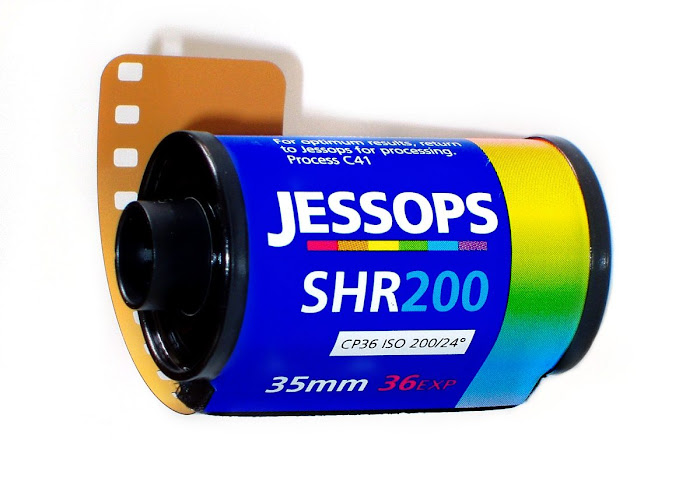
At the time, aside from the aforementioned main Birmingham Jessops store, the original Birmingham Jessops store remained at 69 Smallbrook Queensway - one of a total 123 branches nationwide. Expansion was at an aggressive stage, and by the following year Jessops had bought out two more camera shops in Birmingham city centre - Cequip (the former Cine Equipment) on Colmore Row, and Tecno on Suffolk Street. The brand had also moved the New Street branch to Temple Row as a flagship “World Camera Centre”. Jessops' high street peak came in 2003, with over 240 branches active. Online megastore purchases were sharply rising by then, but the massive boom in digital camera adoption had helped stave off the high street decline. It's tragic what the Internet and the phone have since done to those one-time hives of knowledge, enthusiasm and experience.

The EWS Class 58s were quick to suffer the consequences of initial Class 66 arrivals. They quickly lost their top freight duties, but could still be found milling around the Bescot area. At Ryecroft Junction, Walsall, Mainline blue 58002 can be seen to have retained most of the front-end decor from its September 1996 Worksop Aberdonian railtour. And no, this is not the week after the charter. It's actually 4th August 1999.
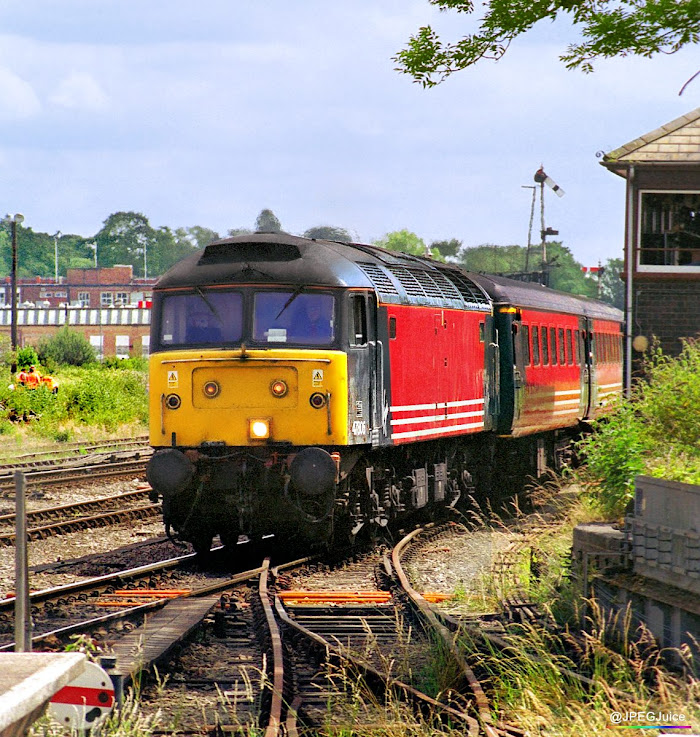
On 24th June 2002, a blockage at Oddingley enforced a diversion of all services on the Gloucester - Birmingham line via Worcester Shrub Hill. With only seven weeks of loco-hauled CrossCountry service left, some of the Class 47-powered diversions were characterised by window-hangers with camcorders, realising it may be their last chance to record an old favourite plodding out of Shrub Hill and/or Droitwich. This is 47806 on the 1M56 Penzance - Manchester. The loco had already been earmarked for conversion to 57309, and so was an urgent photo target at any location.

Another diversion. The Virgin HSTs were not scheduled to run via Tame Bridge Parkway, but here on Mayday 2001, Virgin red 43080 visits the station tailing one of many diverted Virgin services off the Stour Valley line.
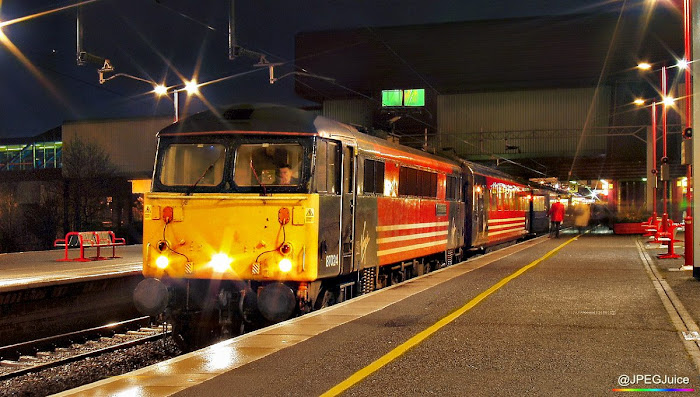
And here we are in the advanced wind-down phase of the old normal. It's 20th November 2003 at Birmingham International, and in the Second City the only regular loco-hauled passenger services left are those from London Euston. CrossCountry is all-Voyager, and Pendolino service is scaling up on West Coast, with the Class 86s already out of the picture. This is 87024, whose entire class will lose its frontline duties within just over a year and a half. Already, the community of enthusiasts had begun to scale down their time at the lineside. The era of going out for one or two specific, special trains, was underway, as the remnants of the old normal diminished to a void.